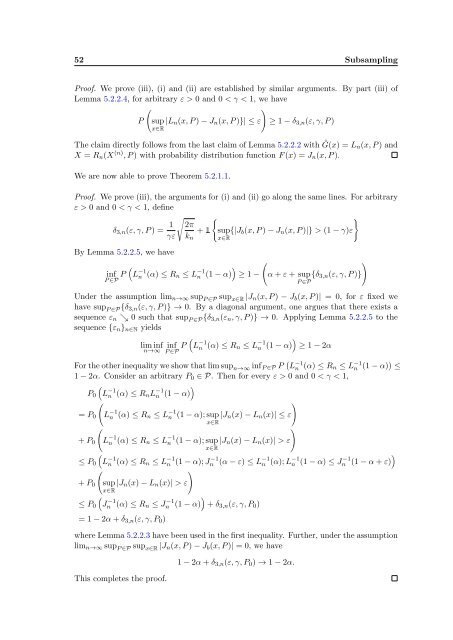Subsampling estimates of the Lasso distribution.
Subsampling estimates of the Lasso distribution.
Subsampling estimates of the Lasso distribution.
Create successful ePaper yourself
Turn your PDF publications into a flip-book with our unique Google optimized e-Paper software.
52 <strong>Subsampling</strong><br />
Pro<strong>of</strong>. We prove (iii), (i) and (ii) are established by similar arguments. By part (iii) <strong>of</strong><br />
Lemma 5.2.2.4, for arbitrary ε > 0 and 0 < γ < 1, we have<br />
(<br />
)<br />
P<br />
sup |L n (x, P ) − J n (x, P )}| ≤ ε<br />
x∈R<br />
≥ 1 − δ 3,n (ε, γ, P )<br />
The claim directly follows from <strong>the</strong> last claim <strong>of</strong> Lemma 5.2.2.2 with Ĝ(x) = L n(x, P ) and<br />
X = R n (X (n) , P ) with probability <strong>distribution</strong> function F (x) = J n (x, P ).<br />
We are now able to prove Theorem 5.2.1.1.<br />
Pro<strong>of</strong>. We prove (iii), <strong>the</strong> arguments for (i) and (ii) go along <strong>the</strong> same lines. For arbitrary<br />
ε > 0 and 0 < γ < 1, define<br />
δ 3,n (ε, γ, P ) = 1<br />
√ {<br />
}<br />
2π<br />
+ 1 sup{|J b (x, P ) − J n (x, P )|} > (1 − γ)ε<br />
γε k n x∈R<br />
By Lemma 5.2.2.5, we have<br />
(<br />
)<br />
L −1<br />
n (α) ≤ R n ≤ L −1<br />
n (1 − α) ≥ 1 −<br />
(<br />
inf P<br />
P ∈P<br />
α + ε + sup{δ 3,n (ε, γ, P )}<br />
P ∈P<br />
Under <strong>the</strong> assumption lim n→∞ sup P ∈P sup x∈R |J n (x, P ) − J b (x, P )| = 0, for ε fixed we<br />
have sup P ∈P {δ 3,n (ε, γ, P )} → 0. By a diagonal argument, one argues that <strong>the</strong>re exists a<br />
sequence ε n ↘ 0 such that sup P ∈P {δ 3,n (ε n , γ, P )} → 0. Applying Lemma 5.2.2.5 to <strong>the</strong><br />
sequence {ε n } n∈N yields<br />
lim inf<br />
n→∞<br />
(<br />
inf P<br />
P ∈P<br />
L −1<br />
n<br />
)<br />
(α) ≤ R n ≤ L −1<br />
n (1 − α) ≥ 1 − 2α<br />
For <strong>the</strong> o<strong>the</strong>r inequality we show that lim sup n→∞ inf P ∈P P ( L −1<br />
n (α) ≤ R n ≤ L −1<br />
n (1 − α) ) ≤<br />
1 − 2α. Consider an arbitrary P 0 ∈ P. Then for every ε > 0 and 0 < γ < 1,<br />
(<br />
)<br />
P 0 L −1<br />
n (α) ≤ R n L −1<br />
n (1 − α)<br />
(<br />
)<br />
= P 0 L −1<br />
n (α) ≤ R n ≤ L −1<br />
n (1 − α); sup |J n (x) − L n (x)| ≤ ε<br />
x∈R<br />
)<br />
+ P 0<br />
(<br />
≤ P 0<br />
(<br />
L −1<br />
n<br />
L −1<br />
n<br />
(α) ≤ R n ≤ L −1<br />
n<br />
(α) ≤ R n ≤ L −1<br />
n<br />
+ P 0<br />
(sup |J n (x) − L n (x)| > ε<br />
x∈R<br />
(<br />
)<br />
≤ P 0 Jn<br />
−1 (α) ≤ R n ≤ Jn −1 (1 − α) + δ 3,n (ε, γ, P 0 )<br />
= 1 − 2α + δ 3,n (ε, γ, P 0 )<br />
(1 − α); sup |J n (x) − L n (x)| > ε<br />
x∈R<br />
)<br />
(1 − α); Jn<br />
−1 (α − ε) ≤ L −1<br />
n (α); L −1<br />
n (1 − α) ≤ Jn −1 (1 − α + ε)<br />
)<br />
where Lemma 5.2.2.3 have been used in <strong>the</strong> first inequality. Fur<strong>the</strong>r, under <strong>the</strong> assumption<br />
lim n→∞ sup P ∈P sup x∈R |J n (x, P ) − J b (x, P )| = 0, we have<br />
This completes <strong>the</strong> pro<strong>of</strong>.<br />
1 − 2α + δ 3,n (ε, γ, P 0 ) → 1 − 2α.<br />
)
















